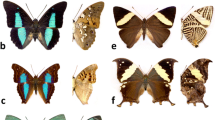Summary
Starting from field investigations and experiments on mimetic butterfly populations a model for two mimetic species is developed. The model comprises various features such as the growth rates and carrying capacities of the two species, their unpalatability to predators, the recruitment and the training of the predators and, most important, the similarity of the two mimetic species. The model ranges from pure Batesian to pure Müllerian mimicry over a spectrum of possible cases. The mimetic gain is introduced as the relative increase in equilibrium density in a mimetic situation as compared to a situation where mimicry is not present. The dependence of this quantity on parameters as growth rate, carrying capacity, unpalatability, and similarity is investigated using numerical methods.
Similar content being viewed by others
References
Bates HW (1862) Contributions to the insect fauna of the Amazon Valley, Lepidoptera: Heliconidae. Trans Linn Soc Lond 23:495–566
Bobisud LE, Potratz CJ (1976) One-trial versus multitrial learning for a predator encountering a model-mimic system. Amer Nat 110:121–128
Bovey P (1941) Contribution a l'étude génétique et biogéographique de Zygaena ephialtes D. Revue Suisse de Zoologie 48:1–90
Bowers MD (1980) Unpalatability as a defense strategy of Euphydryas phaeton (Lepidoptera: Nymphalidae). Evolution 34 (3):586–600
Brodie Jr ED, Brodie III ED, Differential avoidance of mimetic salamanders by free-ranging birds. Science 208, Nr 4440:181–182 (April 1980)
Brower JVZ (1960) Experimental studies of Mimicry, IV. The reactions of starlings to different proportions of models and mimics. American Naturalist 94:271–282
Brower LP, Brower JVZ (1964) Birds, butterflies, and plant poisons: A study in ecological chemistry. Zoologica 49:137–159
Brower LP, Ryerson WN, Coppinger LL, Glazier SC (1968) Ecological chemistry and palatability spectrum. Science 161:1349–1351
Brower LP, Pough FH, Meck HR (1970) Theoretical investigations of automimicry, I. Single trial learning. Proceedings of the National Academy of Sciences of the United States of America, 66:1059–1066
Bullini L, Sbordoni V, Ragazzini P (1969), Mimetismo mülleriano in popolazioni italiane di Zygaena ephialtes (L) (Lepidoptera, Zygaenidae). Archivio Zoologico Italiano, 54:181–214
Clarke CA, Sheppard PM (1971) Further studies on the genetics of the mimetic butterfly Papilio memnon L. Philosophical Transactions of the royal Society of London 263:35–70
Clarke CA, Sheppard PM (1972) The genetics of the mimetic butterfly Papilio polytes L. Philosophical Transactions of the Royal Society of London 263:431–458
Dryja A (1959), Badania nad polimorfizmem krasnik zmiennego (Zygaena ephialtes L.). Panstwowe Wydawnictwo Naukowe. Warszawa, p 402
Estabrook GF, Jespersen DC (1974), Strategy for a predator encountering a model-mimic system. Amer Nat 108:443–457
Fisher RA (1930), The Genetical Theory of Natural Selection, Oxford University Press, Oxford, 2nd revised edition, Dover, New York (1958)
Huheey JE (1964) Studies of warning coloration and mimicry IV. A mathematical model of model-mimic frequencies. Ecology 45:185–188
Huheey JE (1976) Studies in warning coloration and mimicry. VII. Evolutionary consequences of a Batesian-Müllerian spectrum: a model for Müllerian mimicry, Evolution 30:86–93
Lea RG, Turner JRG (1972) Experiments on mimicry: II. The effects of a Batesian mimic on its model. Behavior 38:131–151
Matessi C, Cori R (1972) Models of Population Genetics of Batesian Mimicry, Theoret Popul Biol 3:41–68
Müller F (1879) Ituna and Thyridia; a remarkable case of mimicry in butterflies. Trans Roy Entom Soc, XX–XXIX
Nur U (1970) Evolutionary rates of models and mimics in Batesian mimicry. Amer Nat 104:477–486
Pough FM, Brower, LP, Meck HR, Kessel SR (1973) Theoretical investigations of auto-mimicry: multiple trial learning and the palatability spectrum. Proceedings of the National Academy of Sciences of the United States of America 70:2261–2265
Reichl ER (1958) Zygaena ephialtes L. I. Formenverteilung und Rassengrenzen im niederöstereichischen Raum. Zeitschrift der Wiener Entomologischen Gesellschaft 43:250–265
Reichl ER (1957) Zygaena ephialtes L. II. Versuch einer Deutung der Rassen- und formenverteilung auf populationsgenetischer Basis. Zeitschrift der Wiener Entomologischen Gesellschaft 44:50–64
Remington JE, Remington CL (1957) Mimicry, a test of evolutionary theory. Yale Sci. Mag. 32:10–11, 13–14, 16–17, 19, 21
Rothschild M (1961) Comments in Sheppard PM. Recent genetical work on polymoprhic mimetic Papilios. Symposia of the Royal Entomological Society of london, pp 20–29
Rothschild M (1963) Is the Buff Ermine (Spilosoma lutea (Huf.)) a mimic of the White Ermine (Spil osoma lubricipeda (L.))? Proceedings of the Royal Entomological Society of London, (A) 39:159–164
Royama T (1970) Factors governing the hunting behaviour and selection of food by the great tit (Parus maior), J Animal Ecol. 39:619–668
Scarpelli G (1978) Thesis, Institute of Zoology, Rome University
Sbordoni V, Bullini L, Scarpelli G, Forestiero S, Rampini M (1979) Mimicry in the burnet moth Zygaena ephialtes: population studies and evidence of a Batesian-Müllerian situation, Ecological Entomology 4:83–93
Sheppard PM (1959) The evolution of mimicry: a problem in ecology and genetics. Cold Spring Harbour Symposia on Quantitative Biology 24:131–140
Waldbauer GP, Sheldon JK (1971) Phenological relationship of some aculeate Hymenoptera, their dipteran mimics, and insectivorous birds. Evolution, 25:371–382
Wegner A (1979) Nr. 341 in Bombus, Faunistische Mitteilungen (Hamburg) Band 2 Heft 65:257–260
Author information
Authors and Affiliations
Rights and permissions
About this article
Cite this article
Hadeler, K.P., de Mottoni, P. & Tesei, A. Mimetic gain in batesian and Müllerian mimicry. Oecologia 53, 84–92 (1982). https://doi.org/10.1007/BF00377140
Received:
Issue Date:
DOI: https://doi.org/10.1007/BF00377140




